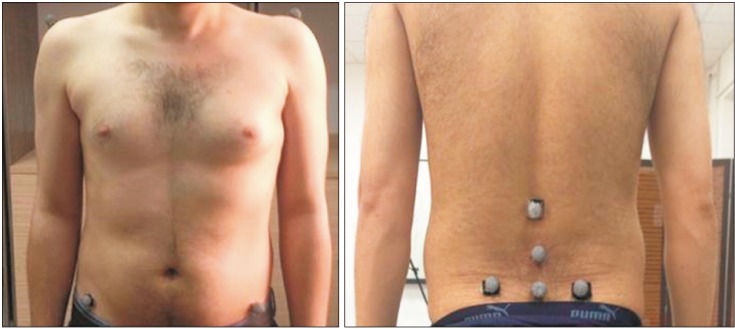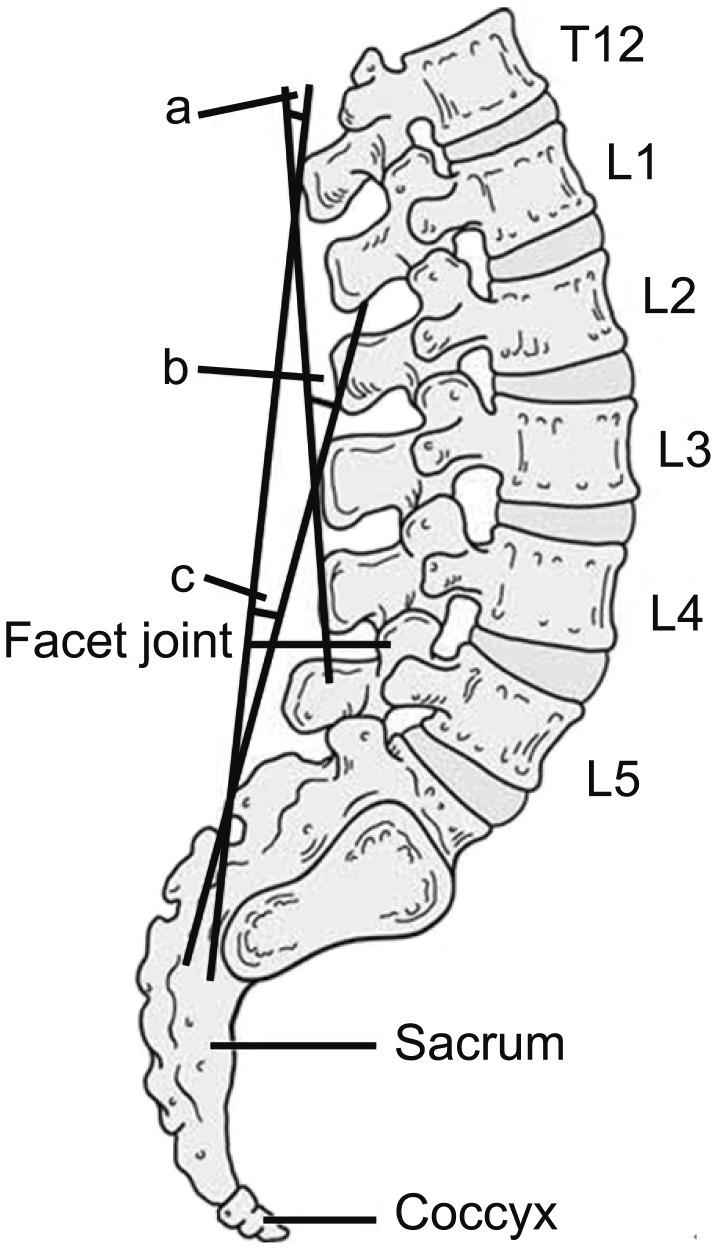Ann Rehabil Med.
2018 Apr;42(2):239-249. 10.5535/arm.2018.42.2.239.
Gender-Related Differences in Reliability of Thorax, Lumbar, and Pelvis Kinematics During Gait in Patients With Non-specific Chronic Low Back Pain
- Affiliations
-
- 1Rehabilitation Research Center, Department of Physiotherapy, School of Rehabilitation, Semnan University of Medical Sciences and Health Services, Semnan, Iran.
- 2Department of Physiotherapy, School of Rehabilitation Sciences, Iran University of Medical Sciences, Tehran, Iran. rasool.bagheri@ymail.com
- 3Department of Ergonomics, University of Social Welfare and Rehabilitation Sciences, Tehran, Iran.
- KMID: 2432194
- DOI: http://doi.org/10.5535/arm.2018.42.2.239
Abstract
OBJECTIVE
To evaluate test-retest reliability of trunk kinematics relative to the pelvis during gait in two groups (males and females) of patients with non-specific chronic low back pain (NCLBP) using three-dimensional motion capture system.
METHODS
A convenience sample of 40 NCLBP participants (20 males and 20 females) was evaluated in two sessions. Participants were asked to walk with self-selected speed and kinematics of thorax and lumbar spine were captured using a 6-infrared-cameras motion-analyzer system. Peak amplitude of displacement and its measurement errors and minimal detectable change (MDC) were then calculated.
RESULTS
Intraclass correlation coefficients (ICCs) were relatively constant but small for certain variables (lower lumbar peak flexion in female: inter-session ICC=0.51 and intra-session ICC=0.68; peak extension in male: inter-session ICC=0.67 and intra-session ICC=0.66). The measurement error remained constant and standard error of measurement (SEM) difference was large between males (generally ≤4.8°) and females (generally ≤5.3°). Standard deviation (SD) was higher in females. In most segments, females exhibited higher MDCs except for lower lumbar sagittal movements.
CONCLUSION
Although ICCs were sufficiently reliable and constant in both genders during gait, there was difference in SEM due to difference in SD between genders caused by different gait disturbance in chronic low back pain. Due to the increasing tendency of measurement error in other areas of men and women, attention is needed when measuring lumbar motion using the method described in this study.
Keyword
MeSH Terms
Figure
Reference
-
1. Gombatto SP, Brock T, DeLork A, Jones G, Madden E, Rinere C. Lumbar spine kinematics during walking in people with and people without low back pain. Gait Posture. 2015; 42:539–544. PMID: 26380913.
Article2. Lamoth CJ, Meijer OG, Daffertshofer A, Wuisman PI, Beek PJ. Effects of chronic low back pain on trunk coordination and back muscle activity during walking: changes in motor control. Eur Spine J. 2006; 15:23–40. PMID: 15864670.
Article3. Lamoth CJ, Meijer OG, Wuisman PI, van Dieen JH, Levin MF, Beek PJ. Pelvis-thorax coordination in the transverse plane during walking in persons with nonspecific low back pain. Spine (Phila Pa 1976). 2002; 27:E92–E99. PMID: 11840116.
Article4. Savigny P, Watson P, Underwood M. Guideline Development Group. Early management of persistent non-specific low back pain: summary of NICE guidance. BMJ. 2009; 338:b1805. PMID: 19502217.
Article5. Steele J, Bruce-Low S, Smith D, Jessop D, Osborne N. Lumbar kinematic variability during gait in chronic low back pain and associations with pain, disability and isolated lumbar extension strength. Clin Biomech (Bristol, Avon). 2014; 29:1131–1138.
Article6. Steele J, Bruce-Low S, Smith D, Jessop D, Osborne N. A randomized controlled trial of limited range of motion lumbar extension exercise in chronic low back pain. Spine (Phila Pa 1976). 2013; 38:1245–1252. PMID: 23514876.
Article7. van den Hoorn W, Bruijn SM, Meijer OG, Hodges PW, van Dieen JH. Mechanical coupling between transverse plane pelvis and thorax rotations during gait is higher in people with low back pain. J Biomech. 2012; 45:342–347. PMID: 22078275.
Article8. Vogt L, Pfeifer K, Portscher M, Banzer W. Influences of nonspecific low back pain on three-dimensional lumbar spine kinematics in locomotion. Spine (Phila Pa 1976). 2001; 26:1910–1919. PMID: 11568705.
Article9. Kim T, Chai E. Trunk and pelvic coordination at various walking speeds during an anterior load carriage task in subjects with and without chronic low back pain. J Phys Ther Sci. 2015; 27:2353–2356. PMID: 26311982.
Article10. McGinley JL, Baker R, Wolfe R, Morris ME. The reliability of three-dimensional kinematic gait measurements: a systematic review. Gait Posture. 2009; 29:360–369. PMID: 19013070.
Article11. Andersson EI, Lin CC, Smeets RJ. Performance tests in people with chronic low back pain: responsiveness and minimal clinically important change. Spine (Phila Pa 1976). 2010; 35:E1559–E1563. PMID: 20634779.12. Malliou P, Gioftsidou A, Beneka A, Godolias G. Measurements and evaluations in low back pain patients. Scand J Med Sci Sports. 2006; 16:219–230. PMID: 16895526.
Article13. Baker R. Measuring walking: a handbook of clinical gait analysis. London: Mac Keith Press;2013.14. Mieritz RM, Bronfort G, Kawchuk G, Breen A, Hartvigsen J. Reliability and measurement error of 3-dimensional regional lumbar motion measures: a systematic review. J Manipulative Physiol Ther. 2012; 35:645–656. PMID: 23158469.
Article15. Niknam H, Esteki A, Salavati M, Kahrizi S. Reliability of Zebris motion analysis system in healthy athletes and athletes with anterior cruciate ligament reconstruction. Asian J Sports Med. 2017; 8:e42040.
Article16. McDermott A, Bolger C, Keating L, McEvoy L, Meldrum D. Reliability of three-dimensional gait analysis in cervical spondylotic myelopathy. Gait Posture. 2010; 32:552–558. PMID: 20832318.
Article17. de Vet HC, Terwee CB, Ostelo RW, Beckerman H, Knol DL, Bouter LM. Minimal changes in health status questionnaires: distinction between minimally detectable change and minimally important change. Health Qual Life Outcomes. 2006; 4:54. PMID: 16925807.
Article18. Parkinson S, Campbell A, Dankaerts W, Burnett A, O'Sullivan P. Upper and lower lumbar segments move differently during sit-to-stand. Man Ther. 2013; 18:390–394. PMID: 23473753.
Article19. Mitchell T, O'Sullivan PB, Burnett AF, Straker L, Smith A. Regional differences in lumbar spinal posture and the influence of low back pain. BMC Musculoskelet Disord. 2008; 9:152. PMID: 19014712.
Article20. Dvorak J, Vajda EG, Grob D, Panjabi MM. Normal motion of the lumbar spine as related to age and gender. Eur Spine J. 1995; 4:18–23. PMID: 7749901.
Article21. Hidalgo B, Gilliaux M, Poncin W, Detrembleur C. Reliability and validity of a kinematic spine model during active trunk movement in healthy subjects and patients with chronic non-specific low back pain. J Rehabil Med. 2012; 44:756–763. PMID: 22847223.
Article22. Harsted S, Mieritz RM, Bronfort G, Hartvigsen J. Reliability and measurement error of frontal and horizontal 3D spinal motion parameters in 219 patients with chronic low back pain. Chiropr Man Therap. 2016; 24:13.
Article23. Mieritz RM, Bronfort G, Jakobsen MD, Aagaard P, Hartvigsen J. Reliability and measurement error of sagittal spinal motion parameters in 220 patients with chronic low back pain using a three-dimensional measurement device. Spine J. 2014; 14:1835–1843. PMID: 24216400.
Article24. Fernandes R, Armada-da-Silva P, Pool-Goudzwaard AL, Moniz-Pereira V, Veloso AP. Three dimensional multi-segmental trunk kinematics and kinetics during gait: Test-retest reliability and minimal detectable change. Gait Posture. 2016; 46:18–25. PMID: 27131171.
Article25. Fernandes R, Armada-da-Silva P, Pool-Goudzwaard AL, Moniz-Pereira V, Veloso AP. Test-retest reliability and minimal detectable change of three-dimensional gait analysis in chronic low back pain patients. Gait Posture. 2015; 42:491–497. PMID: 26349524.
Article26. Streiner DL, Norman GR, Cairney J. Health measurement scales: a practical guide to their development and use. Oxford: Oxford University Press;2015.27. Haghdoost AA, Mirzazadeh A, Alikhani S. Secular trend of height variations in Iranian population born between 1940 and 1984. Iran J Public Health. 2008; 37:1–7.28. Drake R, Vogl AW, Mitchell AW. Gray's anatomy for students. 2nd ed. Philadelphia: Churchill Livingstone;2009.29. Whittle MW, Levine D. Measurement of lumbar lordosis as a component of clinical gait analysis. Gait Posture. 1997; 5:101–107.
Article30. Wagner JM, Rhodes JA, Patten C. Reproducibility and minimal detectable change of three-dimensional kinematic analysis of reaching tasks in people with hemiparesis after stroke. Phys Ther. 2008; 88:652–663. PMID: 18326055.
Article31. Akhbari B, Salavati M, Mohammadi F, Safavi-Farokhi Z. Intra- and inter-session reliability of static and dynamic postural control in participants with and without patellofemoral pain syndrome. Physiother Can. 2015; 67:248–253. PMID: 26839452.
Article
- Full Text Links
- Actions
-
Cited
- CITED
-
- Close
- Share
- Similar articles
-
- Correction: Gender-Related Differences in Reliability of Thorax, Lumbar, and Pelvis Kinematics During Gait in Patients With Non-specific Chronic Low Back Pain
- Effect of Lumbar Extensor Strengthening in Chronic Low Back Pain Patients
- Comparison of Gait Analysis Using High-heeled Shoes and High-forefoot Shoes
- Clinico-radiologic Findings of the Whole Spine in Patients with Chronic Low Back Pain
- Rehabilitative Treatments of Chronic Low Back Pain



